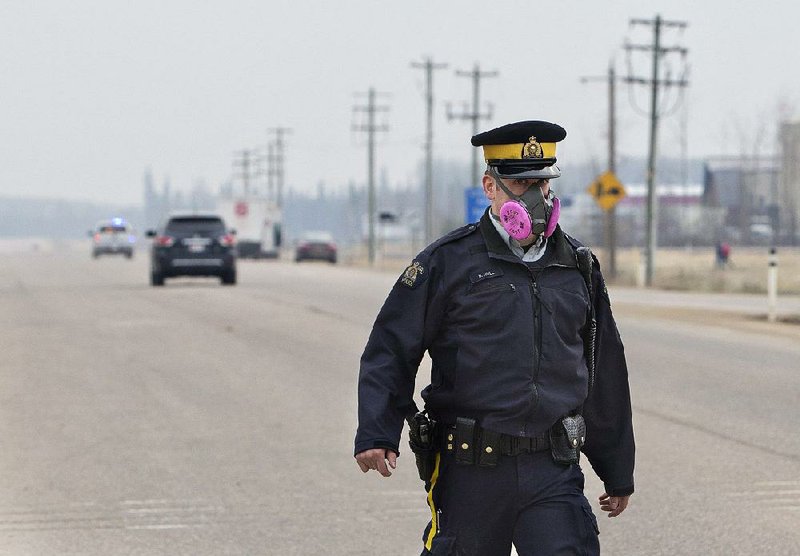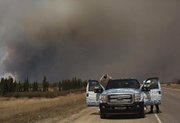FORT McMURRAY, Alberta -- Canadian officials began evacuating 8,000 people from work camps north of Fort McMurray by air Thursday and hoped to move thousands more in a highway convoy today, if it is safe, as an Alberta wildfire grew to more than 210,000 acres.
Officials had flown 4,000 evacuees to Edmonton and Calgary by late Thursday. A helicopter is to fly ahead of an evacuation convoy this morning to ensure that Alberta 63 is safe to travel. The convoy would pass through Fort McMurray, where the fire has torched 1,600 homes and other buildings.
The Alberta government said Thursday that more than 1,100 firefighters, 145 helicopters, 138 pieces of heavy equipment and 22 air tankers were fighting 49 wildfires, seven of which were considered out of control.
Alberta Premier Rachel Notley said that over a period of 48 hours more than 80,000 people were evacuated from the city, which essentially has two roads out of it. Fort McMurray is surrounded by wilderness and is Canada's main oil sands town. The region has the third-largest reserves of oil in the world behind Saudi Arabia and Venezuela.
Notley said financial support will be provided to Albertans and that cash cards may be made available for evacuated residents.
"Our focus right now is on getting those people south as quickly as possible," Notley said.
There have been no injuries or deaths from the fires. The Alberta government has declared a state of emergency and announced a ban on burning across the province, which is roughly the size of Texas.
The fire grew from 29 square miles Tuesday to about 39 square miles Wednesday, and by Thursday it was more than eight times that -- almost 330 square miles.
The fire is wrapped around the western and southern edges of the city.
Unseasonably warm weather combined with dry conditions have transformed the forest in much of Alberta into a tinderbox. Chad Morrison with AB Wildfire, manager of wildfire prevention, said the cause of the fire is under investigation, but it started in a remote forested area and could have been started by lightning.
"Let me be clear: Air tankers are not going to stop this fire," he said. "It is going to continue to push through these dry conditions until we actually get some significant rain."
Bill Patzert, a climatologist at NASA's Jet Propulsion Laboratory in California, said the fire began between the snowy season and the springtime rains.
"In a way, it's a perfect storm," he said. "It's been warm, it's been dry and windy. It's the in-between period before you're in the full bloom of spring."
Prime Minister Justin Trudeau said in Parliament on Thursday that it was "the largest fire evacuation in Alberta's history."
"Homes have been destroyed. Neighborhoods have gone up in flames. The footage we've seen of cars racing down highways while fire races on all sides is nothing short of terrifying," Trudeau said.
Mary Thomas was one of those who escaped by car. She watched in horror as the town's Super 8 hotel and the newly opened Denny's restaurant were swallowed by flames.
"I couldn't control my tears," said Thomas, 46, who fled with her husband and two children. "It's so hard to imagine how we'll move on."
Trudeau called on all Canadians "to support our friends and neighbors at this difficult time," saying the federal government will match individual charitable donations to the Red Cross.
Bill Stewart, co-director of the Center for Fire Research and Outreach at the University of California-Berkeley, said the wind-driven flames in Alberta are spreading embers well beyond fire lines.
"You could add five times the number of firefighters, but you can't get all the embers," he said. "There's no way to put out every ember flying over firefighters' heads."
Notley said the infrastructure for oil and gas production remains largely unaffected.
"As things stand now, the industry will be well-positioned to ramp back up once the fire is under control," Notley said. "It will depend on how long it takes for people to be able to return to work in and around Fort McMurray."
Peter Fortna, who has lived in Fort McMurray since 2008, wasn't optimistic.
"What happens when the community is gone? What happens when people don't come back?" said Fortna, 36. "It's going to take time to rebuild Fort McMurray, and in the meantime, we're going to become a fly-in, fly-out community. All those camps that were empty are going to be filled."
Fortna, a consultant who does advocacy work for disadvantaged communities, said he plans to rebuild his town house, even though his property value fell by more than a third during the recent oil slump.
"I have lots of friends, though, who couldn't sell their house ... and this is their way out," Fortna said.
Sheldon Dahl, a 36-year-old husband and father of three, drove south as flames lapped at the sides of Alberta 63. He drove under a sky of orange with smoke seeping into his minivan for the worst five-minute stretch as he left Fort McMurray.
"It felt like I was in a disaster movie," Dahl said. "It was surreal."
The high school teacher plans to rebuild his destroyed home, although he's not certain he will have a job when he returns.
"We have entire neighborhoods that are gone," Dahl said. "Will we have students to put in these schools?"
Information for this article was contributed by Rob Gillies and Scott Smith of The Associated Press and by Rebecca Penty of Bloomberg News.
A Section on 05/06/2016

